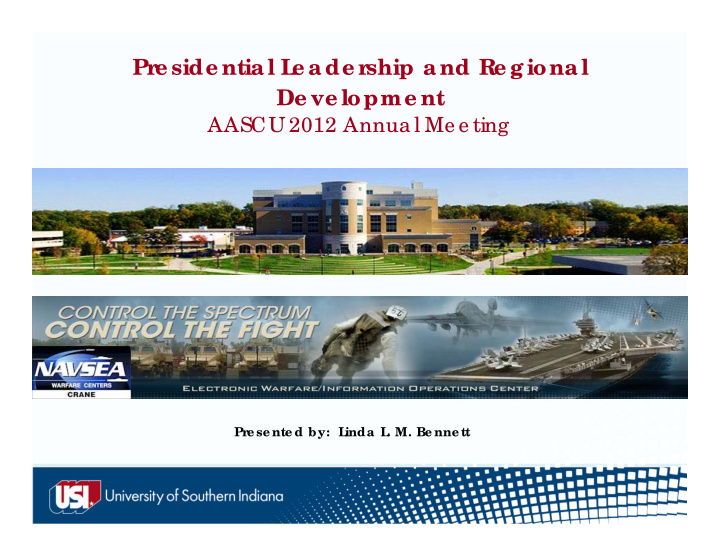



Pre side ntia l L e a de rship a nd Re g iona l De ve lopme nt AASCU 2012 Annua l Me e ting Pre se nte d by: L inda L . M. Be nne tt
E le me nts of Pa rtne rship � USI – ST E M Re sourc e Ce nte r � L e a de rship in Re g ion- Sta te is pa rt of USI stra te g ic pla n � Cra ne NWC – Inc re a se pipe line for future sc ie ntists � Cra ne NWC – Inc re a sing e mployme nt ba se of Ph.D.s
Cha lle ng e s a nd Be ne fits • Pe rc e ptio ns • Re so urc e s • Re puta tio n/ Re c o g nitio n • L e a rning E xpe rie nc e
F uture Visio n Cra ne NWC Ne w se g me nt of I- 69 Innova tion Corridor USI - E va nsville
President Bennett -- Presentation Notes for AASCU 2012 Panel Discussion Partnership with the Crane Naval Warfare Center Partnership began in 2007 with an educational agreement. o USI is a STEM regional resource center. Crane seeking to populate a pipeline of future scientists and technicians. (very brief explanation of both institutions) o Crane seeking to increase Ph.D. employment on its campus and looking for a deeper educational partnership and sense of exchange. USI seeking expertise in subfields not available on campus and ways of creating applied research opportunities for faculty and students. Challenges in forming a targeted regional partnership Focus on perceptions and resources Perceptions Regional economic development presentation that dismissed the impact of institutions such as USI because “you’re not a basic research university.” o Difficulty in seeing what a state public university has to offer apart from generating graduates. Low expectations of intellectual capital. How to build shared purpose between a university campus and a military campus. One of Crane’s goals for the “warfighter” is to enable a “kill within 15 minutes.” USI’s goals not that deadly. Resources Intellectual capital is stretched thin (heavy teaching loads, commitment to travel the distance between sites). The usual pattern of giving course release to allow one or more faculty members to pursue the partnership with Crane was not going to work over the long haul. We had to invest in a person who could be on the Crane campus full time, and bi-lingual (educationese and militarese). Time: How to build a sense of shared mission. 1
Success – How to manage legal/IP issues. Quantifiable benefits to institution and region Reputational benefit to USI – regional and national recognition for “innovation discovery process” (IP mining) and tech transfer o 2009 FLC Midwest Regional Partnership Award o 2010 Department of Defense Technology Transfer Integrated Planning Team Conference – Innovation discovery process designated as a “best practice.” o 2011 UPCEA Recognition of Excellence Award for Innovations in Outreach and Engagement o 2012 FLC Midwest Regional Appreciation Award Eco Devo potential for region IP Mining – 5 events with 23 projects reviewed o 104 potential disclosures identified o 345 commercialization potentials 21 inventions disclosed and filed 19+ external partners exposed and trained 8 signed leases 6 PIA partnerships Thinking outside the manufacturing/agricultural box for the region Commercialization Academy success during summer 2012 – engineering and business students. What leadership have I given? Made the initial investment in an on-site liaison when I was still provost – continued focus once I stepped into president’s office. That continuity helped keep us on task, particularly when long-time USI Outreach leader retired. Many personal visits to Crane, and their Technical Director comes to USI. 2
Bully pulpit to help shape understanding of the potential of the intellectual capital that exists on our campus. Long-term economic/workforce benefits? Visioning an “I - 69” Innovation Corridor that will widen the partnership and invite more collaboration. We are the catalyst institution, but many others will own parts of its future. STEM education efforts strengthen the regional schools surrounding Crane. More activity in summer camps and greater interest in STEM disciplines. 3
Recommend
More recommend